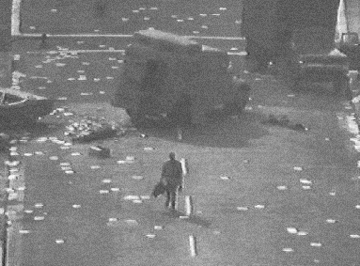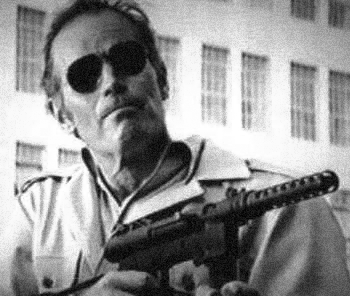 |
 |
 |
 |
 |
 |
 |
 |
 |

The Last Man on Earth is Not Alone
The Omega Man
"The Last Man on Earth is Not Alone."
By the release of The
Omega Man in 1971, the post-apocalyptic action genre was fully realized
and all the conventions firmly in place. The discord in American society
in the early 1970s was not so much racial as generational. The film was
made in the midst of the Vietnam conflict and although there are no direct
references to it, the tensions in the United States color many parts of
the film. Some of the racial elements that were seen in The World,
The Flesh, and the Devil are still in evidence, but the racial issue
overall is much more muted and much less is made of it.
The Omega Man exists in the same Urban Oasis as The World, The Flesh, and the Devil, but along with the abandoned cars and general trash, there remain many decaying bodies throughout the city. The buildings remain standing and the surviving population is very small so there is no need to reseed. Like The World, The Flesh, and the Devil, enough supplies remain for Dr. Robert Neville (Charlton Heston) to scavenge what he needs from deserted Los Angeles. Neville believes he is the last person on Earth, and he is also the only one immune to the plague that caused the depopulation, because he injected himself with his own experimental vaccine. He is found by a small band of children and teenagers who have not died from the plague, but are slowly mutating from its effects. These children are this film's Civilized, living just outside the city to avoid the Barbarians, Matthias and his Family. The Family members were not killed by the plague either, but have mutated from it, becoming extremely light-sensitive and delusional. Under those delusions, Matthias gained power and preaches to his Cult against the "users of the wheel." They fear technology, because it is technology that destroyed the world, and believe themselves to be the keepers of a new technology-free world. Neville must fight The Family in his attempts to cure and rescue the children. It is the vaccine within Neville's blood that can save the next generation, the ones who have not yet "gone over." During his final battle, Neville rids the city of Matthias and his Family, but sacrifices his own life in the process. In doing this, Dr. Neville rescues the Civilized from the Barbarians enabling them to escape the stifling Oasis to begin again in the Sanctuary of the wilderness, making himself the genre's martyr Hero.
In 1971, the United States was still sending troops to Vietnam to fight the forces of Communism. The China-Russia border war that leads to the release of the plague in The Omega Man is similar enough to Vietnam to invite analogy but distant enough that the filmmakers could deny overt anti-Vietnam leanings. One of Neville's flashbacks shows escalating tensions in the United States over a Chinese-Russian conflict. In a later flashback, the plague's creators are theorized to be the Chinese. The Cold War paranoia and sentiments against Communism remain, but are now altered by the "Hot War" in Vietnam.
New methods were being used
in the fighting overseas and the fear of these new implements of war changed
the way in which the world could meet its end. The weapon is no longer
atomic as in The World, The Flesh, and the Devil or even the stray
virus of The Last Man on Earth; it became intentional germ warfare
sent to us from a communist superpower. The man-made supervirus that wipes
out virtually all of mankind and makes those who do not die into an even
greater threat to the living replaced the Bomb and even Nature as the
ultimate threat. The post-apocalyptic action film continually adapts itself
to the time in which it is made, finding new and horrible ways in which
mankind will meet its demise. 
Neville's refusal to leave the apartment that he occupied before the disaster,
even in light of the continual attacks by Matthias's family, echoes the
United States refusal to abandon a losing fight in Vietnam. In 1971 the
United States, deeply entrenched in Vietnam, rejected all pleas to pull
its forces out of the midst of the conflict. Similarly Neville is deeply
entrenched in the apartment where he lived prior to the disaster. When
he is asked why he continues to stay, he says "Well that's where
I live. It's where I used to live. Where I'm gonna live. And not Matthias
or his family or any other son of a bitch is going to make me leave."
This was the American government's attitude towards pulling out of Vietnam
when public support of the conflict turned to resistance. Before the disaster,
Neville was a Colonel in the Army in charge of formulating antidotes for
possible biological weapons. This aligns Neville with the U.S. Military,
and therefore his thinking would be that of the current military. He has
the technological superiority and believes himself to hold the moral high
ground against the Family, mutated by a disease from communist China.
Only his constant vigilance can keep the savage forces at bay.
In 1971 the so-called youth counter-culture was a strong contingent against the Vietnam conflict and an established segment of American society. Although Neville was not a part of the counter-culture before the disaster, he has come to identify with it in retrospect. Early in the film, Neville drives to a movie theater, which advertises the counter-culture concert film Woodstock on its marquee. Neville has rigged a generator to the projector in order to watch the film. It is clear that he has seen Woodstock multiple times, as he is to able recite dialogue along with the film. Neville enjoys the film because the plea for harmony appeals to his desire to left in peace rather than be terrorized by The Family. The quote he recites while in the theater states this desire both from himself and from the counter-culture that attended the 1969 concert. "This is really beautiful man, you know, like, you have to realize man the turnabout I've gone through in the last three days, and just to see, just to really realize, what's really important. What's really important is the fact that if we can't all live together and be happy, if you have to be afraid to walk out on the street, if you have to be afraid to smile at somebody, right? What kind of a way is that to go through this life?" Because of his age, Neville could would not have been a member of the counter-culture, but the disaster has made him understand and sympathize with their beliefs.
Neville's identification with the Woodstock concert-goers enables him to trust and befriend Lisa and Dutch, two young adults who obviously belong to the youth counter-culture. Together, they protect a small group of children in the Urban Wasteland from harm. Except for Neville, they all are infected with the disease but have yet to exhibit any symptoms. A Black Militant type, Lisa sports a large Afro and refers to Neville as "The Man". Dutch, a medical student before the disaster, tracks progress of the disease of the children. Dutch has the general look and demeanor of an Easy Rider type of hippie. He rides a motorcycle, has long hair, and proudly wears his leather jacket, which features a painted fist with an extended middle finger. Their compound in a slightly rural part of the city resembles that of an early Seventies commune; many people of different ethnic background live and work together for the good of the remaining civilized. With these two counter-culture icons as the guardians of the remaining children and therefore the future, it is up to Neville as the last remaining member of the previous generation to protect and guide this generation as much as he can.
Both Lisa and Dutch ally themselves with Neville in their own way. Dutch has a great deal of knowledge of Neville's past work from his experiences in medical school and respects Neville's violent attitude toward The Family. When Neville asks what Dutch did when a friend of his succumbed to the disease's mutation, Dutch answers, "I did just like you do, Doctor, I killed him." Dutch also states that he had applied to BioWar Labs, Neville's former employer, but the disaster stopped him from being hired. In this way Dutch can be seen as the Boomer generation version of Neville. Lisa warms to Neville and the two become romantically involved. While Dutch idolizes Neville in many ways, Lisa lacks the medical knowledge to be like Neville and therefore settles for being with him. Because of her involvement with Neville, Lisa is scared to admit it when she begins to show signs of mutation. Thus Neville loses her and eventually his life in seeking revenge. Dutch is left to take the children and the blood that contains the serum away from the Urban Wasteland to rebuild apart from the old civilization, which has now completely wiped itself out. The responsibility passes from Neville's generation to Dutch's in a show of generational harmony that was virtually unknown in 1971.
Not only does The Omega Man exhibit peace between generations, it also presents a state of race relations much improved from The World, The Flesh, and the Devil. Lisa and Neville are aware of their racial differences, but that does not interfere with their romance the way it would have before the disaster. As they get closer and the relationship moves toward a sexual level, the racial issue is only implicitly discussed. One evening at Neville's apartment, Lisa asks Neville what he is thinking, and he replies "Well you know the old song, 'If you were the only girl in the world and I were the only boy,' okay, but until then don't bother me? I guess I'm the only boy." With this Neville acknowledges that the two of them would never have gotten involved if the disaster had not occurred, but, unlike Burton in The World, The Flesh, and the Devil, Neville is willing to reevaluate the values of the pre-disaster world in light of the post-apocalyptic reality. While race relations had improved since the late '50s, certain issues such as interracial relationships were still sensitive subjects, and so Lisa and Neville's affair reflects a progressive attitude.
That they have an explicit sexual encounter on screen is even bolder. Sex played a large role in creating the generation "gap" of the 1960s and '70s, as the counter-culture youth engaged in "free love." This sexual revolution was fueled by the wide availability of the Pill. After becoming sexually involved, Neville and Lisa scavenge through a pharmacy for supplies. Lisa is amused when she finds birth control pills on the shelf. She laughs and throws them aside. The increased concern over birth control in the '70s was rooted in a fear of overpopulation, and while repopulation is not yet a priority for the survivors, neither is it a cause for any anxiety. They have survived not only the film's disaster but also the sexual revolution of the 1960s.
Still concerned with the issues of the day, The Omega Man is the post-Woodstock, post-sexual revolution Post-Apocalypse. The genre is reordered with the values and fears of the 70s intact. As the genre matures the action driven plot line takes precedence over the human drama of the early entries. While The World, The Flesh, and the Devil has its one chase sequence, The Omega Man has many exciting action pieces throughout its running time. With Charlton Heston's two Post-Apocalyptic vehicles The Planet of the Apes (1968) and The Omega Man the Post-Apocalyptic Action Film emerges as a full-fledged genre.
